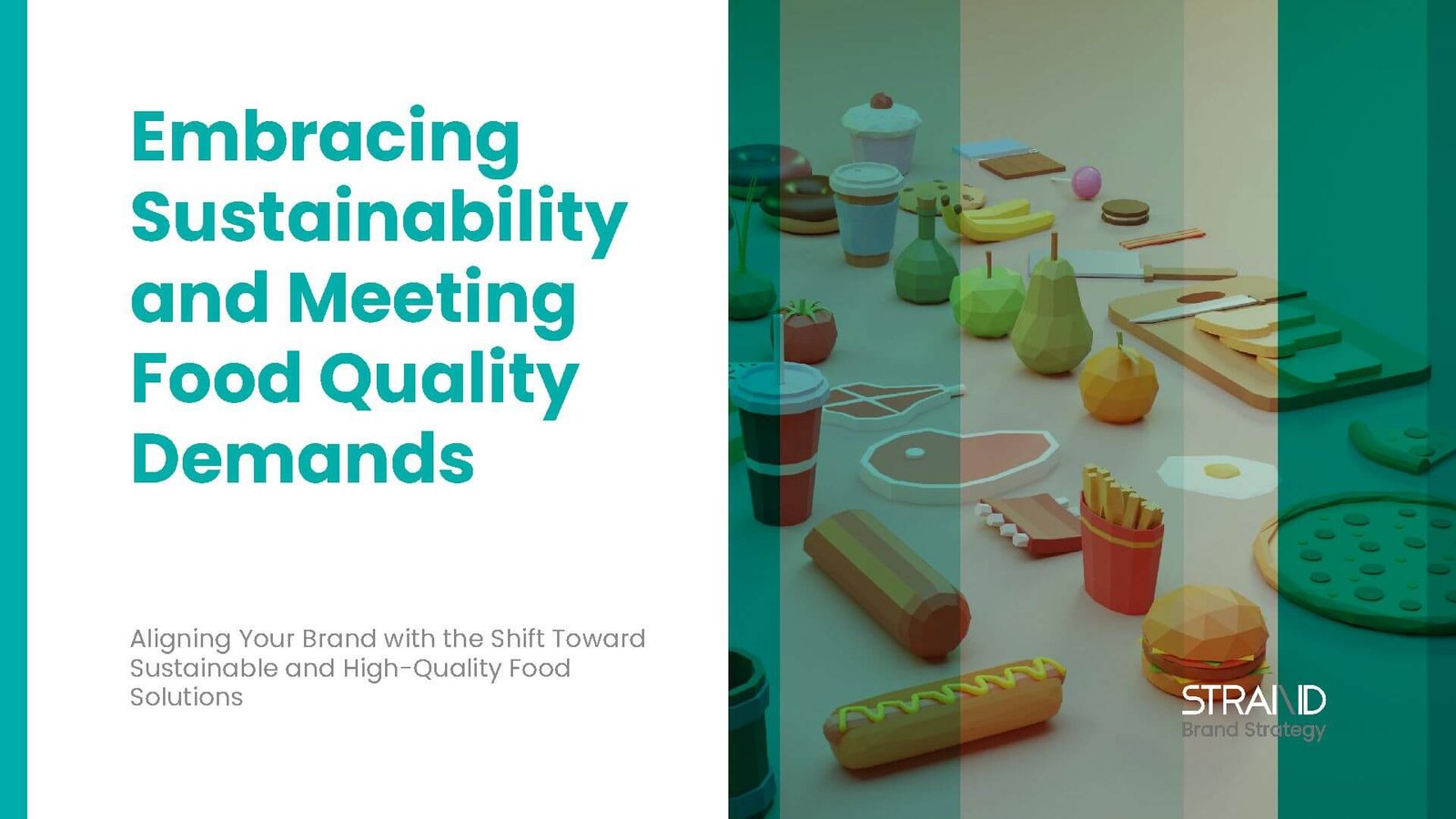Agriculture & Food Processing: Embracing Sustainability and Meeting Food Quality Demands
6 minutes | 20 Nov 2024Aligning Your Brand with the Shift Toward Sustainable and High-Quality Food Solutions
Recently, agriculture and food processing industries have transformed significantly, driven by an increased focus on sustainability and food quality. As consumers become more conscious of the environmental impact of their food choices and demand higher standards for food safety and quality, businesses in these sectors must adapt to stay competitive. This article explores the current trends in agriculture and food processing, the importance of brand alignment in this context, and offers strategic insights for startups, MSMEs, and MNCs to effectively position themselves in this evolving market.
Understanding the Agriculture & Food Processing Landscape
The agriculture and food processing sectors encompass a broad range of activities, from crop cultivation and livestock management to food production and distribution. The emphasis on sustainability and food quality shows a shift toward responsible practices that meet consumer and stakeholder expectations.
Current Trends/Data
- Shift to Sustainability: There is a growing emphasis on sustainable agricultural practices, such as organic farming, regenerative agriculture, and precision farming. According to the Food and Agriculture Organization (FAO), sustainable agriculture practices are crucial for reducing environmental impact and ensuring food security. The global organic food market is expected to reach $1 trillion by 2027, driven by increasing consumer demand for eco-friendly and ethically produced food (Grand View Research, 2023).
- Demand for Food Quality: Consumers are increasingly prioritizing food safety, quality, and traceability. This shift is reflected in the rising demand for certifications such as GlobalGAP and USDA Organic, as well as the growing popularity of farm-to-table and locally sourced food. The global food quality testing market is projected to grow from $16 billion in 2022 to $24 billion by 2027, highlighting the increasing focus on maintaining high standards (MarketsandMarkets, 2023).
Implications
These trends indicate that businesses in agriculture and food processing must align their brand strategies with sustainability and quality to meet consumer expectations and regulatory standards. This involves not only adopting sustainable practices but also effectively communicating these efforts to build trust and differentiate themselves in the market.
Examples
- Ben & Jerry’s: Known for its commitment to sustainability, Ben & Jerry’s has integrated social and environmental responsibility into its brand strategy. The company uses Fairtrade-certified ingredients and supports sustainable agriculture practices, reinforcing its brand values of ethical sourcing and environmental stewardship.
- Dr. Bronner’s: This company has built its brand around organic and fair-trade ingredients. Dr. Bronner’s commitment to sustainability and high-quality products has helped it establish a strong reputation and loyal customer base.
Challenges and Opportunities
Factors/Drivers
- Regulatory Requirements: The agriculture and food processing industries are subject to stringent regulations regarding food safety, environmental impact, and sustainability. Navigating these regulations can be complex, particularly for smaller businesses with limited resources.
- Consumer Expectations: As consumers become more informed and concerned about sustainability and food quality, businesses must continuously adapt to meet these expectations. This requires ongoing investment in technology, practices, and transparency.
- Supply Chain Complexity: Ensuring sustainability and quality throughout the supply chain can be challenging. Businesses must manage various aspects, including sourcing, production, and distribution, while maintaining compliance with environmental and quality standards.
Challenges/Opportunities
- Challenge: Complying with sustainability and quality regulations can be costly and resource-intensive. Startups and MSMEs may struggle with the financial and logistical demands of implementing and maintaining these standards.
- Opportunity: By adopting sustainable practices and emphasizing food quality, businesses can differentiate themselves in a competitive market. This alignment can enhance brand reputation and attract environmentally and health-conscious consumers.
- Challenge: Communicating sustainability and quality initiatives effectively to consumers can be difficult. Companies must develop clear and compelling messaging to convey their commitment and achievements.
- Opportunity: Leveraging technology and innovation can streamline operations and improve sustainability. Investing in precision agriculture, blockchain traceability, and advanced food processing boosts efficiency, ensuring higher product quality and sustainability.
Stakeholder Impact
- Consumers: Consumers are increasingly demanding transparency and accountability from food producers. Businesses that align their brand with these expectations can build stronger relationships and brand loyalty.
- Regulators: Regulatory bodies are focused on ensuring compliance with environmental and food safety standards. Companies must stay informed about regulatory changes and demonstrate their commitment to meeting these requirements.
- Investors: Investors are increasingly interested in companies that prioritize sustainability and quality. Businesses that can demonstrate their alignment with these values may attract investment and support.
Strategic Solutions for Brand Alignment
Proposed Solutions
- Develop a Clear Brand Proposition: Define your brand’s unique value proposition in the context of sustainability and food quality. Highlight your commitment to responsible practices, high standards, and transparency.
- Enhance Brand Awareness: Invest in marketing and communication strategies that emphasize your sustainable practices and quality standards. Utilize digital platforms, certifications, and partnerships to build brand visibility and credibility.
- Align Brand Personality: Ensure your brand personality reflects the values of sustainability, integrity, and excellence. This includes demonstrating a commitment to environmental stewardship, quality assurance, and ethical practices.
- Position Strategically: Position your brand as a leader in sustainable and high-quality food solutions. Clearly communicate your niche and strengths, and differentiate yourself from competitors through your brand values and practices.
- Prioritize Innovation and Transparency: Invest in technologies and practices that enhance sustainability and food quality. Implement systems for traceability, engage in sustainable sourcing, and adopt innovative processing techniques.
Case Studies
- Patagonia Provisions: Patagonia Provisions has built its brand around sustainable food production, using regenerative agriculture practices and focusing on high-quality, environmentally friendly products. The brand’s commitment to sustainability and transparency has helped it establish a strong market presence.
- Blue Apron: Blue Apron has leveraged its focus on high-quality ingredients and sustainability to differentiate itself in the meal kit delivery market. The company emphasizes its commitment to sourcing fresh, responsibly produced ingredients and reducing food waste.
Future Outlook
- Increased Focus on Circular Economy: The adoption of circular economy principles, including waste reduction and resource efficiency, will become more prominent in agriculture and food processing.
- Growth of Sustainable Packaging: Sustainable packaging solutions, such as biodegradable and recyclable materials, will play a crucial role in meeting consumer demands and reducing environmental impact.
- Technological Advancements: Innovations in areas such as precision agriculture, vertical farming, and food technology will continue to drive improvements in sustainability and food quality.
Conclusion for Becoming a Brand
The agriculture and food processing sectors are undergoing significant changes driven by a focus on sustainability and food quality. To succeed in this evolving market, businesses must align their brand strategies with these trends, emphasizing their commitment to responsible practices and high standards.
By adopting a strategic approach to brand alignment, businesses in agriculture and food processing can navigate the challenges and seize the opportunities presented by the shift towards sustainability and quality. Leveraging the STRAND 5S Framework can help organizations define their brand aspirations, analyze industry trends, align their strategies, build awareness, and implement actionable solutions.
The future of agriculture and food processing will be shaped by continued advancements in sustainability and food quality. Companies aligning brand strategies with sustainability trends can lead in agriculture and food processing, meeting evolving consumer and stakeholder expectations.
Explore strategies for agriculture and food processing businesses to enhance brand presence, foster growth, and adapt confidently to industry changes. Ready to transform your brand? Contact STRAND today to explore how our brand strategy workshops can help you achieve your strategic goals.

